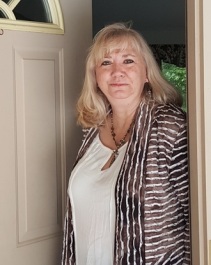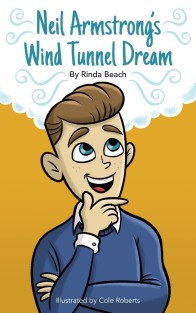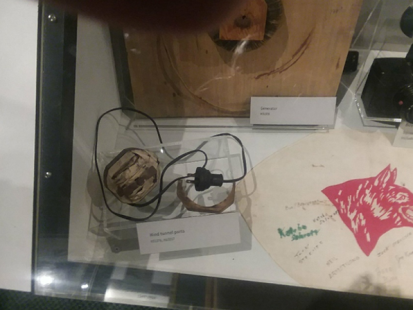Hey Math is Everywhere Readers,
Just in time for last-minute holiday shopping for your small scientists and/or intrepid inventors, we have Rinda Beach here with us today to talk about her debut chapter book Neil Armstrong’s Wind Tunnel Dream.
Bio –
 Rinda never planned to write. She was a second-grade teacher who read and told stories, until the night a bat paid her a visit. It inspired her to write. She learned how to edit, thanks to SCBWI, writing classes, and critique partners. Rinda substitute teaches to stay connected to today’s kids. She uses her knowledge and imagination to write stories for them. Her website features a weekly blog and book review for kids. She expanded her career to open a company, Beach Girl Press. Visit Rinda at www.rindabeach.com
Rinda never planned to write. She was a second-grade teacher who read and told stories, until the night a bat paid her a visit. It inspired her to write. She learned how to edit, thanks to SCBWI, writing classes, and critique partners. Rinda substitute teaches to stay connected to today’s kids. She uses her knowledge and imagination to write stories for them. Her website features a weekly blog and book review for kids. She expanded her career to open a company, Beach Girl Press. Visit Rinda at www.rindabeach.com
Kaitlyn: Thank you so much for joining us today, Rinda!
Rinda: Thank you for this opportunity! I’m so glad to be here, to talk to your readers about Neil Armstrong’s Wind Tunnel Dream. It’s my debut book, and my dream come true!
Kaitlyn: I’m so happy you saw your dream become a reality! Why was this such an important story for you to tell?
Rinda: First, I was intrigued with building a wind tunnel. Thinking, Who builds one in high school? No one I know! When I was a senior in 1977, I built a balsa bridge. It held the school record for years, but now it seems primitive compared to what Neil built in 1946.
Then I was blown away by the fact that Neil didn’t build just any old tunnel. He built the Wright Brother’s design, you know, the one that helped them become first in flight? And he did it at age 16!
Finally, as I wrote this book, I realized that its theme was – dreams – Neil’s dreams, mine, and eventually my readers’. When I autograph a book, I write something about dreams. One of my favorites came from Neil. His high school yearbook quote, “He thinks. He acts. Tis done.” I realized that’s how Neil dreamed, and I did too.
Kaitlyn: What a wonderful way of looking at it, all about dreams. What drew you to writing this as a chapter book?
 Rinda: Would you believe this started as a picture book? That’s what I wanted when I started writing, but I went over 1000 words. I had a choice, cut it and make that picture book, or let it grow into a chapter book.
Rinda: Would you believe this started as a picture book? That’s what I wanted when I started writing, but I went over 1000 words. I had a choice, cut it and make that picture book, or let it grow into a chapter book.
I tried cutting, but it felt like the book was weaker. My critique partners encouraged me to push it into a chapter book. They said it would have a bigger market. I tried dividing my manuscript into chapters. Then I grew the word count for our next meeting. I never looked back. My critique partners helped me push my manuscript to be the best book I could write in May of 2019. I’m grateful to all sixteen of them!
Kaitlyn: Critique partners are the best! Speaking of best, you got the best review from a wonderful person: Robert G. Bryant (Ph.D Eagle Scout – NASA Senior Research Engineer The Space Foundation’s Space Technology Hall of Fame 2016 Inductee), how did he discover your book?
Rinda: Back when I was writing this book, Robert Bryant was my daughter’s future father-in-law. I took a chance – I asked him to read my manuscript and write an honest comment for the back cover. I also gave him an out, a chance to say no. Who wants to read something you’re not interested in? Even worse, what if he didn’t like it? YIKES!
I was happy when Rob said he’d read it, but I was over the moon, all puns intended, when he wrote that it was “a wonderful book.” I’m a second-grade teacher. I couldn’t believe a NASA scientist said, “. . . it is not just a young person’s book, but a book for young people.” Yes, I was over the moon!
Kaitlyn: That’s amazing! I can see why he felt that way. In the story, I love how you let us inside Neil’s head. At one point, I actually did a mental fist pump and whooped along with Neil, how do you get in your character’s head to achieve this?
Rinda: I’m so glad you could see inside Neil’s head. That’s exactly what I tried to do. I only knew three facts when I started the book, so I had a lot of room to imagine and stretch the story so you could put yourself inside it.
I started with three basic facts. That’s it! (1) Neil needed four supplies to begin building. (2) He blew a lot of fuses along the way, (3) I had two different endings to choose from. I picked the one where his mother’s housecoat blew off because a couple sources supported it.
When I learned Neil’s mother dropped a jam jar on her foot and broke both of them, all because Neil said he was going to fly Navy fighter jets, I thought OUCH! For the jam jar and those fighter jets! I’m a mom. I can imagine exactly what Viola Armstrong thought, and that’s what I tried to show you in words. My illustrator did it in pictures.
When I decided my original chapters were too short, I had room for more detail, more words to show what Neil was thinking and feeling.
But there was a stronger force that pushed me to find my ‘inner Neil’. It was December, and I was supposed to be done. My mentor, Callie, said my first chapter read like a book report. OUCH! I was hurt, but she was right. I was smart/brave enough to ask which lines read like a book report. After I edited them, she said it was perfect, except for two small places. It was the best critique I’d gotten in my twelve years as a writer.
BTW, I asked for those two small places. Why wouldn’t I? If something is off and I know it, I have to fix it. That’s the perfectionist, or writer in me!
Kaitlyn: Well said! I feel like in writing we’re always reaching to be better. Can you share what research looked like for this book?
Rinda: Wow! I had to go back to look at my manuscript files to answer this question. I did the research back in the spring of 2018. When I decided to write this story. First, I went first to the Armstrong Air and Space Museum where I volunteer, and I met pieces of the original wind tunnel.

Then I interviewed Burt. He’s the docent who knows almost everything about Neil. From there I headed to the library and pulled everything I could find. I focused in on that wind tunnel and Neil’s early years. It helped me write the first hundred words, then the rest of the story.
As I read, I put my notes in Scrivener. It’s like working in a giant notebook. I have 23 files in Neil’s research section. The first five are my original notes. From there I started a new file in Drafts titled ‘Outline with Facts.’ This was originally a picture book so I started with the basic plot points for three act structure, and I put my research into the outline.
The other nice thing about Scrivener is that I can have two screens visible at the same time, side by side. I probably had my Outline on the left screen, and my notes on the right. I can look back and forth as I work. My next step – to finally start writing that first draft. It was on the left, and my outline on the right. Scrivener makes it easy to move your details into the story!
You’d think that would be the end of the research, not even close. I wound up writing ten to fifteen drafts altogether. Every time I thought it was ready, I would take it to one of my two critique groups. They’d pull it apart to find the weaknesses, especially the parts they couldn’t imagine. That was a big signal to go back and do more research. This part came mostly from the internet.
Photos were also part of my research. If I can’t picture something, I can’t write it, so I go on a picture hunt. It was January, and I was finishing the last chapter. I had gone through critiques with both of my groups, and they hit the same snag. They couldn’t picture what Neil did as a test pilot. All my sources used the same sentence that I did. I asked my husband.
The next day he pulled up an old black and white YouTube video of Neil’s test pilot days. I could finally picture that small scene. I rewrote it, and my critique partners could see it, finally! I teared up after I finished that change. I knew it was the last time I’d be editing Neil’s story. I spent almost a year getting to know Neil. I’d like to think that, somehow, we became friends.
Kaitlyn: It sounds like you did become friends through all your hard work. What advice can you give writers about writing chapter books? What are your favorite resources for learning how to write them?
Rinda: The most important thing, research and plot your story. I broke mine into the classic three act structure. From there I broke it into chapters. For me it’s easier to think in terms of story. My best writing resource is Ann Whitford Paul’s book, Writing Picture Books. I learned so much from the earlier version, but I have the new one. My other go-to resource is my critique partners. I had sixteen different writing friends who helped me edit Neil. Editing is the key to writing your best story. I couldn’t have written or self-published this book without them!
Kaitlyn: On your website, you talk about all your fun adventures that you’ve had that inspire your writing, what’s next for you?
Rinda: If you’ve read my website, you know how much I love Norris Lake, Tennessee. It’s inspired two manuscripts that are sitting in my computer. Both are picture books. One is about the darn ducks who think our dock is their poop deck. IT’S NOT! I think it should be published traditionally.
I’m self-publishing the other manuscript in May. My working title is Lake Fun for You and Me. It’s the book I think parents might buy for their kids, especially if it’s positioned next to the t-shirts. In the book, one side of each page has text and a photo that tell a story about a family vacation at Norris Lake, and of course, it’s based on my lake adventures.
The other side of each page will give the reader room to write and illustrate their own version of lake fun, whether it’s Norris or a different lake. I’m editing the words right now. I’m also looking at formatting. I selected the font and used a dummy picture to get an idea of how much room my words can have. Now I really understand why picture book writers are told to leave room for the illustrator. I’ve cut text on all thirteen spreads to allow room for that photo. Experience is the best teacher!
Kaitlyn: Agreed, there’s so many things you don’t realize until you actually go through it. Finally, if you could spend the day with your favorite author, would you rather go outside and fly a kite or sit by a fire with tea?
Rinda: Neither, and I couldn’t pick just one! I’d invite them to my lakehouse with its view of the Cumberland Mountains. I’d hope that the neighborhood bald eagle would swing by for a visit. We’d talk books over coffee and cookies, pop and popcorn, chocolate, or all of the above. Food is a great way to make friends! With the right kind of weather, we’d take a boat ride. There’s no place like my lake!
PS – one of my dreams is to be able to have writing retreats at the lake, with one of my favorite writers for each retreat . . . someday!
Kaitlyn: That sounds amazing! Make sure to invite me! Thank you so much for joining us today, Rinda!
Rinda: It’s my pleasure! I love talking books with anyone who’ll listen. Thanks for the opportunity to share my debut chapter book, Neil Armstrong’s Wind Tunnel Dream with your audience. Now back to work on that debut picture book, Lake Fun for You and Me.
Also, if you want the book in time for the holidays, it’s ON SALE on Amazon right now! They have the hardback on sale for $7.49 – That’s half-price. The Paperback is $7.49, that’s 50 cents off. If you purchase, make sure to leave a review!
Kaitlyn’s review of Neil Armstrong’s Windtunnel Dream
Neil Armstrong’s Windtunnel Dream is a fun fiction book full of wonderful insights about Neil’s life while focusing on his desire to have a wind tunnel to experiment with. Author Rinda Beach does a wonderful job helping the reader feel what Neil is feeling. The beginning starts with a quick jaunt over his early childhood that lead to his wind tunnel focus, and then the next chapter dives into the heart of the story of this vivacious, dedicated boy and his family that helps him reach his dreams.
To find out more about Rinda and her books, check out her website: http://www.rindabeach.com/
If you would like to win a signed copy (US only) of Neil Armstrong’s Windtunnel Dream,
you have three ways to enter:
- Comment on this post
- Share in the comments below that you did a purchase request for the book at your library
- Retweet this tweet about this blog on Twitter
Thank you all for joining us today and HAPPY HOLIDAYS!
Sincerely,
Kaitlyn Leann Sanchez









Kaitlyn, Thanks for making this post look and sound so good! And here’s to making someone’s dream come true when they win a copy of my book!
LikeLiked by 1 person
Aw, you’re so sweet; it was my pleasure. Thank you for making it look and sound so good 😉
LikeLike
As a nonfiction writer, I loved this interview–hearing about Rinda’s process and all the work that went into the book was great and I could definitely relate to it! I look forward to reading the book!
LikeLiked by 1 person
Yay! So glad you enjoyed it Katie. You ladies do SO much work to help readers learn such wonderful things!
LikeLike
Congratulations, Rinda! The book sounds wonderful,; one I want to read.
LikeLiked by 1 person
Aw, that’s so wonderful to hear, Kim. If you don’t win, I hope you get yourself a copy anyway!
LikeLike
Congrats, Kim, you won the drawing for a signed copy of Neil Armstrong’s Wind Tunnel Dream!
LikeLiked by 1 person
Rinda, this book sounds SO fascinating! I love how flight was truly Neil’s passion. And talk about a journey…lovin’ that you got your blurb from a NASA scientist ❤ And I still haven't touched my Scrivener. You've certainly made a case for it 🙂 Great interview, ladies!
LikeLiked by 1 person
Oooh, let us know if you use it and how it works for you!
LikeLiked by 1 person
Ah, that won’t happen till I’m ready for my novels and those have been waiting for years *sigh* I just keep playing with a first chapter and scribbling ideas and notes meanwhile.
LikeLiked by 1 person
You can do it!
LikeLiked by 1 person
Thanks! I haven’t let go of hope yet! (BUT have often wondered if I should :-/) We’ll see!
LikeLiked by 1 person
If you’re having fun, keep at it!😍
LikeLiked by 1 person
Rinda, Thanks for sharing your creative process with us. I’m going to check out Scrivener. I’m writing a chapter book too. And writer group critiques are very helpful. Congratulations on your book being published!
LikeLiked by 1 person
Thanks so much for reading. I’m excited to hear about how the program works for you and how your cb turns out😊
LikeLike